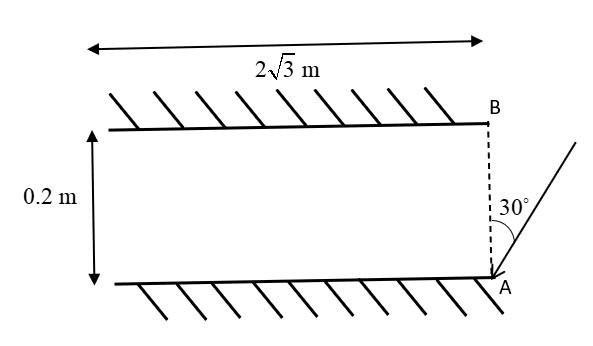
Two plane mirrors A and B are aligned parallel to each other, as shown in the figure. A light ray is incident at an angle of ${30^ \circ }$ at a point just inside one end of A. The plane of incidence coincides with the plane of the figure. What is the maximum number of times the ray undergoes reflection (including the first one) before it emerges out?

A. 28
B. 30
C. 32
D. 34
Answer
215.7k+ views
Hint: The total distance that the ray will cover before emerging out will be equivalent to the length of the plane mirrors. To solve the above question, first calculate the distance that the ray will cover in one reflection and then proceed further to calculate the maximum number of reflections.
Complete answer:
The length of the mirrors is the distance that the ray should cover in order to emerge out.
Separation between the mirrors, $d = 0.2{\text{ m}}$
Let us calculate the distance that the ray covers in the first reflection.
For plane mirrors, the angle of incidence is equivalent to the angle of reflection.
Hence, angle of reflection $ = {30^ \circ }$ .

In the above triangle,
$\tan {30^ \circ } = \dfrac{a}{d}$
Substituting the values,
$\dfrac{1}{{\sqrt 3 }} = \dfrac{a}{{0.2}}$
This gives $a = \dfrac{{0.2}}{{\sqrt 3 }}$
First reflection onwards, the distance covered by each ray would be $\dfrac{{0.2}}{{\sqrt 3 }}$ .
Let the total number of times the ray was reflected including the first one be $n$ , then
$n\left( {\dfrac{{0.2}}{{\sqrt 3 }}} \right) = 2\sqrt 3 $
On simplifying, we get $n = 30$ .
Hence, the maximum number of times the ray undergoes reflection before it emerges is 30.
Thus, the correct option is B.
Note:Angle of incidence is the angle that the incident ray makes with the normal of the mirror and angle of reflection is the angle that the reflected ray makes with the normal of the mirror. In the case of plane mirrors, the angle of incidence is equivalent to the angle of reflection. Use this property of plane mirrors and trigonometric relations to solve the given question.
Complete answer:
The length of the mirrors is the distance that the ray should cover in order to emerge out.
Separation between the mirrors, $d = 0.2{\text{ m}}$
Let us calculate the distance that the ray covers in the first reflection.
For plane mirrors, the angle of incidence is equivalent to the angle of reflection.
Hence, angle of reflection $ = {30^ \circ }$ .

In the above triangle,
$\tan {30^ \circ } = \dfrac{a}{d}$
Substituting the values,
$\dfrac{1}{{\sqrt 3 }} = \dfrac{a}{{0.2}}$
This gives $a = \dfrac{{0.2}}{{\sqrt 3 }}$
First reflection onwards, the distance covered by each ray would be $\dfrac{{0.2}}{{\sqrt 3 }}$ .
Let the total number of times the ray was reflected including the first one be $n$ , then
$n\left( {\dfrac{{0.2}}{{\sqrt 3 }}} \right) = 2\sqrt 3 $
On simplifying, we get $n = 30$ .
Hence, the maximum number of times the ray undergoes reflection before it emerges is 30.
Thus, the correct option is B.
Note:Angle of incidence is the angle that the incident ray makes with the normal of the mirror and angle of reflection is the angle that the reflected ray makes with the normal of the mirror. In the case of plane mirrors, the angle of incidence is equivalent to the angle of reflection. Use this property of plane mirrors and trigonometric relations to solve the given question.
Recently Updated Pages
Circuit Switching vs Packet Switching: Key Differences Explained

Mass vs Weight: Key Differences Explained for Students

Alpha, Beta, and Gamma Decay Explained

Alpha Particle Scattering and Rutherford Model Explained

Angular Momentum of a Rotating Body: Definition & Formula

Apparent Frequency Explained: Formula, Uses & Examples

Trending doubts
JEE Main 2026: Application Form Open, Exam Dates, Syllabus, Eligibility & Question Papers

JEE Main Correction Window 2026 Session 1 Dates Announced - Edit Form Details, Dates and Link

Derivation of Equation of Trajectory Explained for Students

Hybridisation in Chemistry – Concept, Types & Applications

Understanding the Angle of Deviation in a Prism

Understanding Collisions: Types and Examples for Students

Other Pages
JEE Advanced Marks vs Ranks 2025: Understanding Category-wise Qualifying Marks and Previous Year Cut-offs

How to Convert a Galvanometer into an Ammeter or Voltmeter

Atomic Structure: Definition, Models, and Examples

Ideal and Non-Ideal Solutions Explained for Class 12 Chemistry

Degree of Dissociation: Meaning, Formula, Calculation & Uses

Understanding Electromagnetic Waves and Their Importance




